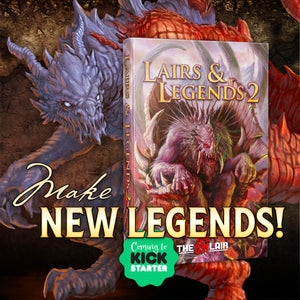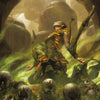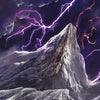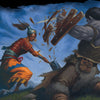Terrain vs. Theater of the Mind: When to Use Each in Your D&D Game

By Luke Hart
I was once in a game where the dungeon master had thousands of dollars worth of Dwarven Forge terrain and miniatures. They had a large room dedicated to housing all their D&D and RPG gear and playing the game. It was an amazing setup, and the terrain and miniatures were absolutely gorgeous. I was very impressed.
Then we actually played the game. Yeah, yeah, no longer impressed.
Here’s the thing. Investing hundreds or thousands of dollars in fancy terrain because your favorite D&D show sponsored it once and got you all hyped up—will not make you a good game master. Backing every single Reaper Bones Kickstarter and then painting minis until your fingers bleed—will not make you a good dungeon master.
And the converse is true, too. Spurning physical terrain and minis, lifting your head snobbishly high, and proclaiming, “In my group, we use theater of the mind because our imaginations are good enough.” – also will not make you a good dungeon master.
The fact is that terrain and minis can often fall short at the game table and NOT be the best option. And the same is true for theater of the mind.
You see, terrain and minis and theater of the mind are all only just TOOLS that a game master has at their disposal. And like any tool, these tools have their time and place, their advantages and disadvantages.
Today, we’re going to talk about the best times to use each and how to strike a BALANCE between using terrain and minis and theater of the mind. Because doing this WILL help you improve as a game master.
By the way, are you a NEW GAME MASTER feeling a bit overwhelmed by everything involved with running a role-playing game? If so, the Secret Art of Game Mastery can help. Get over 100 years of GM experience distilled into practical, easy-to-read advice.
Watch or listen to this article by clicking the video below.
When to Use Terrain & Minis
And a quick note here: when you’re playing online, a virtual tabletop such as Foundry VTT is the equivalent of terrain and minis. So all of these points apply to VTTs as well.
1. When you want to have a complex tactical battle
For combats that feature multiple enemies, elevations, interesting terrain, and where you’d like the players to be able to focus on detailed tactics, terrain and minis is the way to go. Nothing beats being able to see precisely where everyone and everything is during the combat when you want to chose and execute on specific battle tactics. For many groups this is THE REASON to use a grid and minis. At its heart D&D and many other RPGs had their foundations as wargames, and many groups feature a strong element of this in their gameplay. And when you’re wargaming, being able to see everything on the board is the way to go.
2. When precise positions really matter
Sometimes you’re not in combat, but precise positions in a room or area are still really important. My Hand of Light group was once traversing a large cavern covered with traps, all in different areas and squares, so their exact locations in the room and where they stepped was VERY IMPORTANT. Thus, the best way to play that out at the game table was to draw out the room on a grid, plop their minis down on the board, and have them move their minis about as they navigated that particular death trap.
3. To help players visualize a complex room or area
Words are great, and we all love a great narrative description. However, sometimes our ability to descript a place verbally pales in comparison to the simple effectiveness of drawing out the area on a grid or using terrain to reconstruct it. So, when you have a complex area that is better explained visually to your players, some nice terrain or a simple sketch on grid paper will often get the job done better and faster.
4. When you know the party is going to a specific dungeon or place
Isn’t it the ongoing joke that whatever the game master prepares the players will ignore and do something completely different? Well, this is the LAST THING you want happening when you’ve spent an hour or two recreating a dungeon with Dwarven Forge terrain and spend the weekend constructing a mini swamp out of paper mâché, twigs, and plastic baggies. However, when you KNOW just know deep down in your bones that your players absolutely will go to a specific location where terrain and minis would be just perfect to use – well, then you spend the time getting it all set up. You might also get them to sign contracts in their own blood promising not to change their minds, but that might be a step too far.
5. Cool Factor
Let’s face it. Dwarven Forge and well painted minis look so very very cool. And we all love drooling over the images of awesome terrain and mini setups we see on Reddit and Facebook and Twitter. There’s nothing inherently wrong with doing a thing from time to time just because it’s cool. I mean, why do you think the mullet is making a comeback?
When to Use Theater of the Mind
1. When you want to streamline combat
Here’s the thing, when done properly TotM makes combats go FASTER. It’s true; it’s a thing; I’ve experienced it myself. For years and years all I ever did really was gird and minis for my games. But then I started running a D&D game at work over our lunch breaks, and I opted for TotM over hauling in my minis. And, as I got more accustomed to running TotM, and discovered a few tricks for doing so, I also discovered that combats where going MUCH faster than when I would run similar combats with a grid and minis. The biggest tip for making this happen is to let go of precision and specifics and embrace estimates and generalities. However, I do plan to do a future video on running TotM and my tips for doing so.
2. Or when the combat is simple and/or only involves one or two enemies.
Look, not every combat needs to be tactical work of art. Sometimes a fight is probably just going to be a surround and pound against one or two foes. Or it’s against far weaker enemies and the PCs are just going to give them a sound beat down in short order. These are the sorts of situations where you don’t really need to use terrain and minis because you won’t really be leveraging any of the benefits of them; instead, the combat can be run using TotM.
3. When you want to emphasize narrative descriptions and imagination over tactics
Who says that every D&D or RPG combat has to be run as a wargame? Who says that battle tactics are an absolute must-have for every battle? Sometimes it’s a good change of pace to move the focus over to narrative descriptions and imagination, and put battle tactics in the back seat. It’s also possible that in general you and your players may not give a flying crap about combat tactics and wargaming. And you’d rather describe what’s going on and use your imaginations to envision combat – well in either case, TotM is the ticket for you.
4. When you don’t have time to prepare the terrain or VTT map in advance
Let’s face it, game masters sometimes just don’t have the time needed to prepare that beautiful Dwarven Forge setup they’d like to use at the game, or the time to create a map using Inkarnate or another online map-making tool, place it into Roll20, add dynamic lighting, and double-check that nothing got funky on you. And then, of course, sometimes random encounters happen that may not have anticipated. But never fear, dear time-pressed, sleep-deprived, fellow dungeon master, TotM has got your back.
5. When you don’t have any terrain or minis
Yeah, because some of us are broke and just don’t have the cash buy all that cool stuff. Or you’re traveling to a convention or something where it’s difficult to transport terrain and minis. Well, you can always use TotM. It costs nothing and your imagination is easy to take with you.
100 Years of GM Experience at Your Fingertips!
Are you a NEW GAME MASTER feeling a bit overwhelmed by everything involved with running a role-playing game? Are you a VETERAN GAME MASTER looking for new tips and tricks to take your games to the next level? Look no further than the Secret Art of Game Mastery.
We at the DM Lair have distilled our CENTURY of accumulated GM experience into an easy-to-read guide of practical advice that you can immediately apply to your games! We've even included our own templates–the things that we use to prepare our ACTUAL games.
Get all three books to master your game:
- The Secret Art of Game Mastery. Contains over 100 years of GM advice distilled into an easy-to-read format. It introduces and explains the tools of the trade, scheduling, playstyle, post-game notes, getting player feedback, and more.
- The Secret Art of Preparation. Brings to your fingertips the actual templates and guides that the DM Lair team uses to prepare games, Lair Magazine, and more. Designed as a three-ring binder, it's intended for you to write directly into for your entire campaign!
- The Secret Art of Notetaking. Gives you the keys to tracking your campaign from session to session just like the DM Lair team. Designed as a three-ring binder, it's intended for you to write in and keep track of your whole campaign!
With so much knowledge and experience on its pages, The Secret Art of Game Mastery is guaranteed to become an indispensable tool for all game masters, new and veteran alike. And if that isn’t enough, the information applies to all game systems and all genres!
-
Posted in
Game Master How-To Articles







